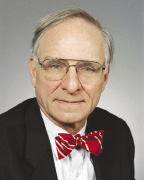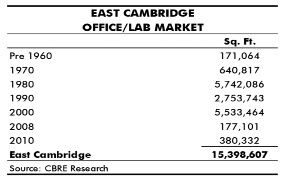With commercial real estate having a global reach and the power of the internet, one of the locations often referenced is East Cambridge. East Cambridge now has huge numbers and unprecedented momentum. The purpose of this article is to:
* Create a case study
* Explain how and why East Cambridge happened
* Address the future of East Cambridge and its long term market position
A Case Study
40 years ago, the Charles River was a barrier to entry. East Cambridge was on few radar screens. Rte. 128 as the technology highway was "what was hot". Along Main St.in Kendall Sq. there were few office buildings.
Badger had built a home office building at One Broadway. MIT, always thinking ahead, had brought in CC&F to develop a 488,527 s/f, three building office park known as Technology Sq. and that was about it.
Vision and the planning process then started. The CRA in the 1978 time frame recognized East Cambridge, created a plan that bridged the Lechmere Canal with Edwin Land Blvd. and laid the ground work for the Cambridge Center.
What happened is that with good planning, the clear vision of MIT and a series of factors I will now describe East Cambridge over 40 years became a market unto itself:
As this article is written, there are 1,540,830 additional s/f under construction for completion by 2014.
East Cambridge Did Not Happen by Chance
To begin, East Cambridge is located in one of fourteen 24-hour cities in the world. In the U.S. there are only 6 (Los Angeles, San Francisco, Chicago, Washington D.C., New York, and Boston). Just because an address is in a 24-hour city does not make that location a success.
The following are the required characteristics:
* The first - Large size.
East Cambridge by my estimate contains 857 acres. There are 13 blocks between the Longfellow Bridge and Charles River Dam. The sites within these blocks are large. If East Cambridge were a series of small sub-divided lots it never would have happened.
* The second - Close to a strong, urban downtown.
East Cambridge is two miles from the center of downtown Boston. The short distance to an urban center is critical.
* The third - Strong transportation linkages.
In the case of East Cambridge there are two "T" stops and multiple state route transportation corridors leading to I-90 and I-93.
* The fourth - MIT cannot be underestimated.
It was their vision (and that of the CRA), which is making East Cambridge happen. An educational link is key.
* The fifth - Limited competition.
East Cambridge's only competition is Boston's Seaport District. Boston's Seaport District is a new "startup" created by the spinoff of Boston's "Big Dig."
* The sixth - Knowledge driven expansion.
Whereas the suburbs were the rage during the last quadrant of the 20th Century, they are not today. It is the 23-37 year olds who are growing our market. Where these people wish to be is in urban settings where they rub shoulders with their compatriots. They are looking at a different lifestyle model than that of their parent's generation.
This generation looks for locational synergy. They look for a special environment. Amenities are important. This includes retail, entertainment, and housing opportunities. In terms of new East Cambridge housing, the following is a small sample with more units under way.
What the Future is All About
What the future is all about is to capture the innovation of present and future leaders of corporate America. East Cambridge has already served as a magnet to Novartis, Microsoft, Google and many, many startups.
What the future is all about is that it is not a game of moving tenants on a checkerboard. It's not about creating another Mid-Town Manhattan. What the future is all about is a new kind of linkage. The linkage is knowledge and the tie of that knowledge to downtown within a recognized 24-hour city. The result is the adding of new dimensions that we are seeing develop in East Cambridge. They are only at their starting point and the full impacts are not yet known.
Over the next 30 years, East Cambridge has the potential to double in size. Much of this will go to North Point because a large land site is available. Another location will be land sites around MIT.
In the U.S., only the 24-hour cities are ones where another East Cambridge (or Seaport) can be created. The need for large land area within a long arrow shot to a major downtown indicates East Cambridge cannot be easily replicated.
East Cambridge is part of a worldwide market. There are a lot of companies who wish to be in the U.S. and East Cambridge is creating a worldwide audience.
Overall, when all market issues are addressed, East Cambridge is just so unique that it will reach a degree of development and success never seen before in this country.
Webster Collins, MAI, CRE, FRICS is an executive vice president/partner within CBRE/New England and co-manages CBRE's Advisory Services Group within the U.S., Boston.











